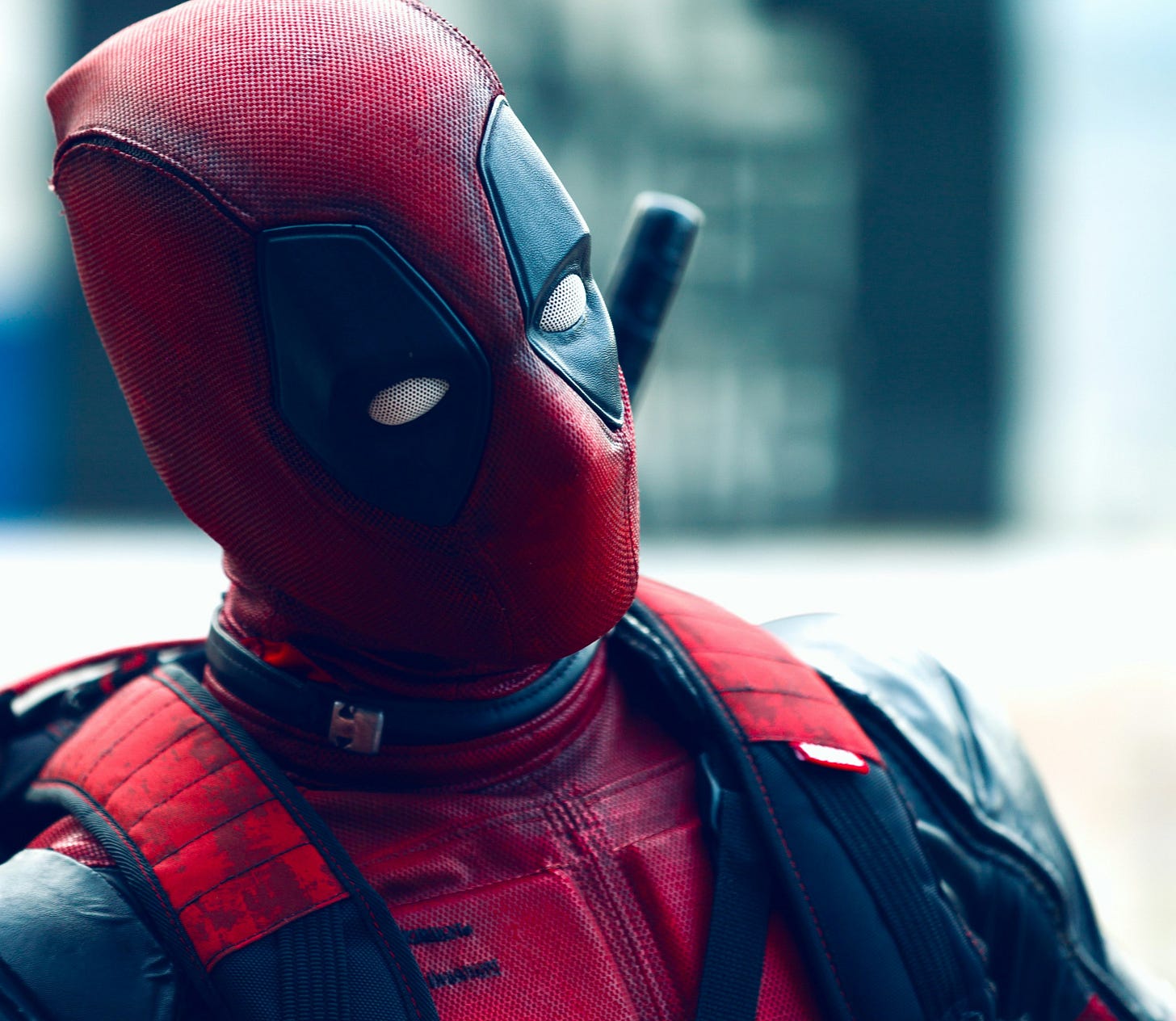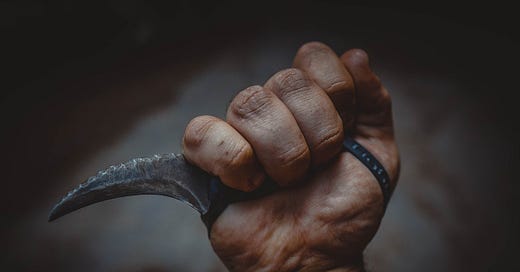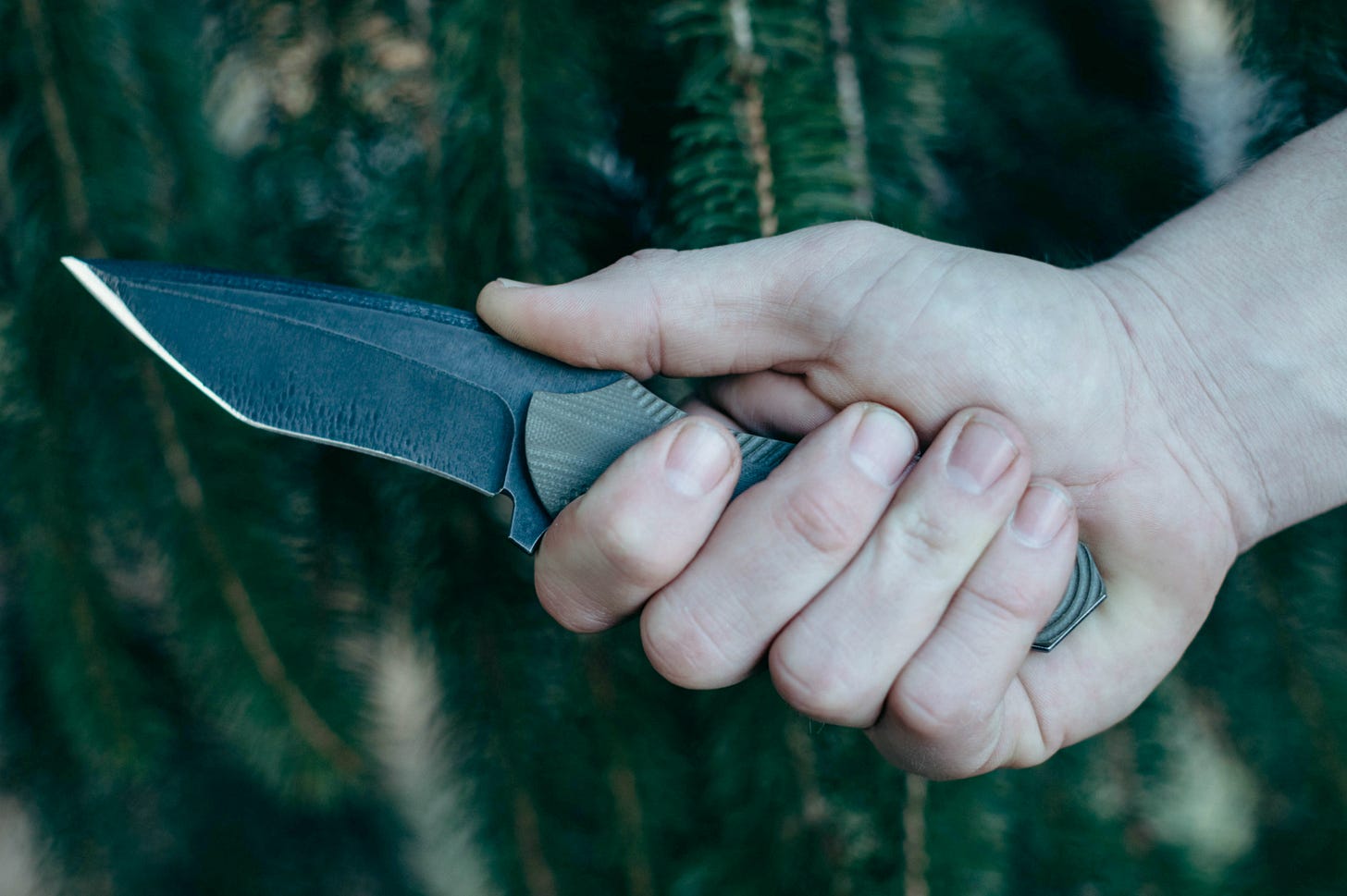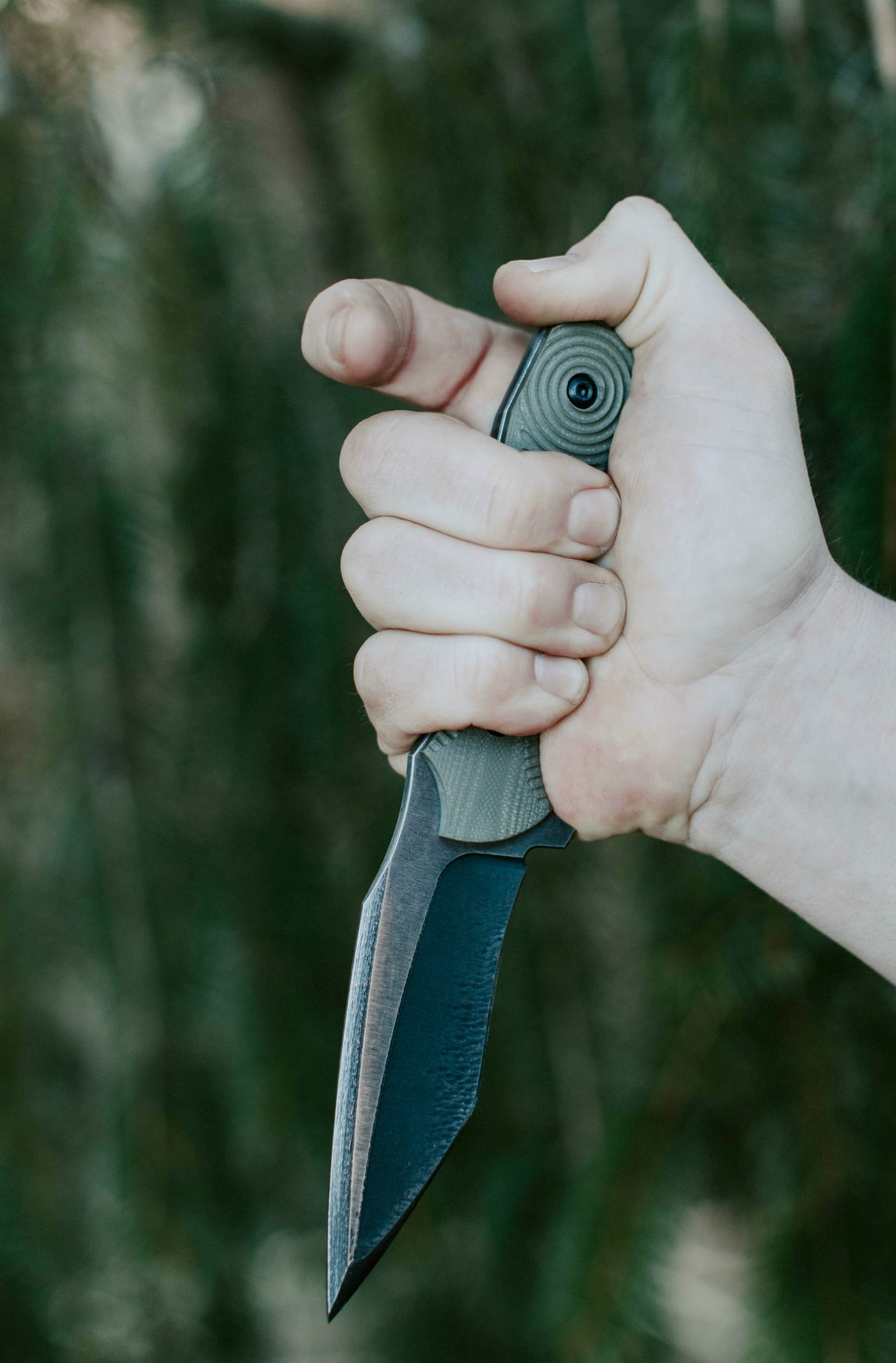3 Reasons Why You Can Bring a Knife to a Gunfight!
How Knives Are Regaining an Edge in Today's Security Landscape.
In this dispatch we’re going to cover…
⚔️ Increasing Knife Threats: Knife attacks are rising as criminals and terrorists favor their concealability and effectiveness in close quarters.
⚔️ Combat Advantages: Knives provide reliability, quick access, and fluid movements, making them superior in extreme close-quarters situations.
⚔️ Smart Knife Selection: Choose practical fixed blades with secure grips and position them for easy access in everyday carry.
Let’s go!
Knives Are Regaining Their Edge in Today's Security Landscape

Since antiquity, humans have used blades to cut, slash, or stab one another in wars and personal disputes. While firearms have overshadowed blades in the modern era, knives are experiencing a resurgence among terrorists, criminals, and even security professionals worldwide.
In this transmission, we will examine current trends in knife attacks, explain the benefits of knives in close quarters, and discuss proper blade selection and mounting techniques for one’s kit. For those who believe the blade has lost all relevance on the battlefield, we will provide modern examples that illustrate why the knife is still the perfect complement to the modern firearm.
Despite the proliferation of guns on the streets, knives remain highly favored among criminals. On average, one thousand police officers are assaulted each year in the United States. Civilians are not immune to these attacks either. It’s been a minute since I’ve looked at recent data, but combing through some old research I had, I found that approximately 15,073 people were stabbed or hacked to death in 2015. This figure is three times the number of those killed by rifles and shotguns combined. I’m not sure what the recent statistics are, but I can’t imaging that number’s gone down.
It’s easy to see why knives are popular. They are convenient, easy to conceal, and readily available. A simple kitchen knife can quickly become a deadly weapon in the hands of a determined attacker.
Knives are incredibly effective. While they may lack the range of firearms, they are by no means less lethal. Terrorists and criminals have repeatedly demonstrated that an attacker armed with a knife can inflict as much harm as any active shooter. Here are just a few examples:
In 2001, a knife-wielding man killed eight children at a school in Osaka, Japan.
In 2008, a man murdered eight people with a knife in his apartment complex in South Korea.
In March 2014, a gang of ten men and women armed with knives attacked over 130 people at a train station in Kunming, China, resulting in at least 28 deaths.
It’s important to note that these attacks do not require a high level of skill or sophistication to be successful. In 2006, a drunken teenager stabbed 41 people at a Berlin train station before being stopped.
Knife attacks are also gaining popularity among terrorists. Organizations like the Islamic State have long encouraged followers to commit individual acts of jihad using knives or other edged implements. In a 2016 issue of its online publication, Rumiyah, the Islamic State advised that "one need not be a military expert or a martial arts master, or even own a gun or rifle in order to carry out a massacre or to kill and injure several disbelievers and terrorize an entire nation." Some have heeded this call.
In November 2015, Faisal Mohammed, an 18-year-old student influenced by Islamic State propaganda, conducted a knife attack at the University of California at Merced, injuring four people. A year later, an alleged Somali jihadist plowed his car into a crowd in Columbus, Ohio, before getting out to stab bystanders, injuring at least 11 before being shot and killed by police. The United States is not alone in facing such threats; Germany, the United Kingdom, and other European countries have suffered similar attacks. Israel, in particular, has endured numerous knife attacks as a result of jihadi terrorism.
Again, this data may be old, but you get the point (no pun intended). Edge weapons carry with them a special lethality.
Let’s Talk About the Good Guys..

While criminals and terrorists may choose knives for their convenience, they are gaining attention among law enforcement, military, and private security personnel for different reasons.
Patrol officers, SWAT members, and military personnel are discovering the advantages of carrying a knife as a backup to their service weapons. In extreme close quarters, a knife is superior to a gun. It never jams, malfunctions, or runs out of ammunition.
Additionally, knives are more difficult to disarm than firearms. The motion of a knife is harder to predict, allowing for fluid attacks that can follow unpredictable patterns, utilizing horizontal, diagonal, and vertical angles. This makes it challenging for an attacker to follow or disarm someone wielding a knife. In fact, attempting to grab the knife aggressively can lead to injury, giving the knife an advantage over firearms when it comes to weapon retention.
Finally, a knife can be deployed as quickly—if not faster—than a firearm. There’s no risk of mechanical failure or running out of ammunition. Knives are also lighter and more concealable, making them an ideal secondary weapon, especially when covert carry is necessary.
Let’s talk knife selection..
There are a host of quality knives on the market in terms of materials, but not all are worthy for carry. Knife selection must be based upon utility rather than looks and aesthetics. Here are some points to keep in mind when choosing a knife for your kit or for everyday concealed carry:
Fixed Blades Are Preferred Over Tactical Folders: While tactical folders have their merits, they cannot compete with fixed blades in terms of speed of deployment and durability.

The Knife Must Have a Finger Guard: When using a knife in close quarters, it’s essential to have an adequate finger guard. The guard, choil, or quillion should be cut in such a way that allows space for your index finger to secure a firm grip when thrusting. Without it, your hand could slip forward, risking injury when thrusting the knife into an object. A single guard on the edge side of the blade is preferred over the double guard found on many classic designs, like the beloved USMC Ka-Bar Fighting Knife of WWII. While nostalgia has its place, a single guard allows your thumb to ride along the spine, facilitating faster blade manipulation and more precise attacks.

A proper finger guard prevents the fingers from sliding along the edge of the blade during a thrusting attack. Also, note how the thumb rides along the spine of the blade. This helps guide the knife and makes faster to manipulate.
Single-Edged Blades Are Preferred: A knife is most lethal when thrusting, not slashing. Slashing attacks can serve a purpose, especially when transitioning to close quarters, but they should ultimately lead to a termination attack delivered via thrusts. A double-edged knife complicates this process, as it prevents you from allowing your thumb to rest along the spine. Without a place for your thumb, you must hold the blade in a tight “hammer-fist” grip, which can create excessive energy in the knife and slow your manipulations.
Knife Placement: Kit vs. Everyday Carry
When mounting a knife to your kit, it should be positioned off-center at the front, with the handle facing upward on either the strong or support side. This positioning allows for a smooth draw without forcing your body into unnatural contortions, enabling you to clear magazines, radios, and other gear you may be carrying.
When it comes to everyday carry (EDC), the placement of your knife is crucial for ensuring quick access while maintaining safety and comfort. For tactical folders, most folks prefer to carry their knives secured with a clip inside the waistband or front pocket, allowing for a discreet and easily accessible option. For fixed blades, a number of companies have finally improved your options for carrying at the appendix position or the back of the your hip.
In either case, the knife should be positioned in a manner that allows for quick indexing and swift deployment. It’s also important to ensure that any clothing or gear you may be wearing does not obstruct your knife’s path. Regular practice with your chosen carry method will help you become more proficient in accessing your knife quickly and safely in high-stress situations.
Conclusion
The blade's relevance in modern combat and self-defense cannot be overstated. As we’ve seen, knives are not only practical and effective tools but also essential components of a well-rounded personal security strategy.
Their resurgence among criminals and terrorists highlights the importance of understanding their potential as both weapons and defensive tools. By recognizing the unique advantages of knives, selecting the right blade, and employing effective carrying techniques, individuals—whether military personnel, law enforcement officers, or civilians—can enhance their preparedness for a variety of threats.
In an era where the unexpected can become a reality, embracing the knife as a viable option ensures that you are equipped for any encounter, reinforcing the age-old adage: when it comes to close combat, it’s not just about the weapon you carry, but how you wield it.
Was today’s post helpful? Then stab that “heart” ❤️ and share it with a buddy. Keep the conversation going!






Benchmade Soc-P spearpoint dagger is amazing. It was created for scenarios where it’s already close quarters or you might already be on the ground because someone surprise rushed you. Guy who created it had Brazilian Jiu Jitsu and wrestling in mind.
It is designed to be drawn and employed immediately because it has a thumbring that brings the handle into your grip as you draw it. Out comes the blade and you’re poking holes in the assailant immediately. And it’s extremely difficult to dislodge it from your grip.
Only downside is that it’s not really set up for straight forward thrusting. It’s more for neck and side stabbing hammerfist style.
Even here in Texas, there are plenty of places where you cannot legally conceal carry pistols, but you can almost always bring a knife.
Defensive knives should be always be carried forward of the hips, if possible. A p'kal style knife or a reverse edge knife is favored by many for its shearing abilities in clearing limbs and allowing continued point driven attacks. Another thing people underestimate when using a knife (or thinking about defending one) is that it is trivial to pass the knife from one hand to another when stabbing. Force on force training will teach many things very quickly. At the last Shivworks course I did the final scenario was a full on simunition/training weapon fight in a car. I got to my knife first and used that before being able to get to the gun.